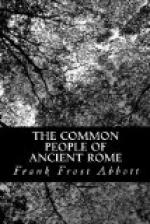Beyond the limits of Latium it came into contact with Oscan and the other Italic dialects, which were related to Latin, but of course were much farther removed from it than the Latin of Tusculum or Lanuvium had been,[2] so that the adoption of Latin was not so simple a matter as the acceptance of Roman Latin by the villages of Latium near Rome had been.
The conflict which went on between Latin and its Italic kinsmen is revealed to us now and then by a Latin inscription, into which Oscan or Umbrian forms have crept.[3] The struggle had come to an end by the beginning of our era. A few Oscan inscriptions are found scratched on the walls of Pompeii after the first earthquake, in 63 A.D., but they are late survivals, and no Umbrian inscriptions are known of a date subsequent to the first century B.C.
The Social War of 90-88 B.C., between Rome and the Italians, was a turning-point in the struggle between Latin and the Italic dialects, because it marks a change in the political treatment of Rome’s dependencies in Italy. Up to this time she had followed the policy of isolating all her Italian conquered communities from one another. She was anxious to prevent them from conspiring against her. Thus, with this object in view, she made differences in the rights and privileges granted to neighboring communities, in order that, not being subject to the same limitations, and therefore not having the same grievances, they might not have a common basis for joint action against her. It would naturally be a part of that policy to allow or to encourage the retention by the several communities of their own dialects. The common use of Latin would have enabled them to combine against her with greater ease. With the conclusion of the Social War this policy gave way before the new conception of political unity for the people of Italian stock, and with political unity came the introduction of Latin as the common tongue in all official transactions of a local as well as of a federal character. The immediate results of the war, and the policy which




